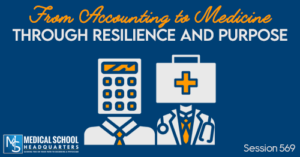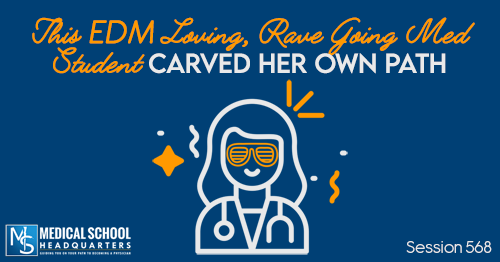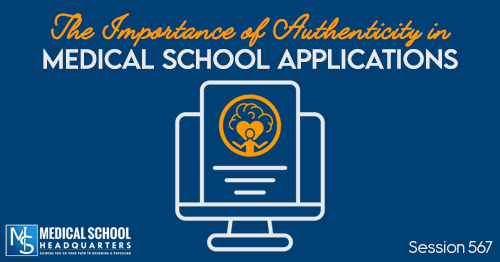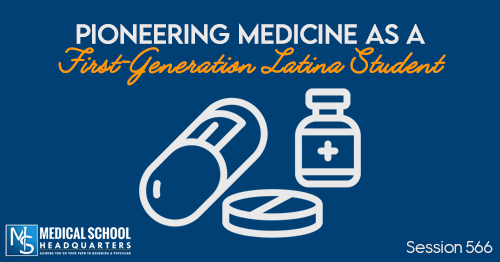Apple Podcasts | Google Podcasts
Session 569
Betsy takes us on her personal journey overcoming obstacles to attend medical school after taking a detour into business. She also discusses the challenges faced by a black woman pursuing a career in medicine.
For more podcast resources to help you with your medical school journey and beyond, check out Meded Media.
Listen to this podcast episode with the player above, or keep reading for the highlights and takeaway points.
Interest in Becoming a Physician
Betsy realized she wanted to be a doctor since childhood. Growing up, she wanted to make her mother proud after they immigrated from the Ivory Coast to the United States and achieve a high level of education, which she felt could be attained through becoming a doctor or lawyer.
She then took a detour into business school after graduating from college as she had doubts about pursuing medicine. But her mother’s death from breast cancer reignited her passion for helping others, especially other women of color who are disproportionately affected by the disease.
This personal experience gave Betsy a renewed sense of purpose and “why” to overcome her doubts and self-doubt. This prompted her to return to medical school to fulfill her childhood dream of becoming a doctor and helping patients in her mother’s memory.
The Impact of a Lack of Diversity
Betsy reflected that a significant factor she had to deal with, as a black woman pursuing a career in medicine, was the lack of diversity she saw among doctors.
When shadowing and gaining clinical experience in medical settings, she did not see many physicians who looked like her. This made it difficult to envision herself succeeding in a field where she did not see role models who shared her background and experiences.
It contributed to her doubts and lack of self-confidence as she questioned why there were so few doctors of color.
“You don’t see yourself in the people you’re trying to be like, and so it’s hard to sort of move forward.”
She felt that if she had more mentors from similar backgrounds to look up to early in her journey, it may have impacted her differently. The lack of representation played a major role in sowing seeds of doubt in Betsy’s mind as she wondered if she could truly become a doctor when so few around her looked like her.
The Lingering Effects of Racism and Bias
Betsy acknowledged that as a black woman pursuing a career in medicine, she had to deal with microaggressions, macroaggressions, and overt racism at various points in her journey. While in medical school, she recalled feeling like an “underdog” or not part of the dominant group as one of few women of color.
She experienced assumptions from patients who mistook her for janitorial staff rather than a physician due to her race.
Betsy also felt extra pressure during examinations for fear that any mistakes would be attributed to her perceived intellectual deficiencies rather than just being a normal part of the learning process, as might be assumed for her white peers. However, she was thankful to attend a school with strong diversity values that helped mitigate some of these challenges.
Now in residency, while proud of her accomplishments, Betsy remains aware of the added barriers faced by physicians who do not fit the traditional mold.
“I was so afraid of being wrong. But that’s really part of the learning process.”
Betsy’s Inspiration: Her Mother’s Fight with Breast Cancer
The Catalyst for Change
Betsy’s mother’s battle with and ultimate death from breast cancer had a profound impact on her. As she cared for her mother during her final months, Betsy witnessed firsthand the suffering of the disease and felt helpless that she did not have the medical knowledge or skills to better assist her mother.
A Personal Mission
This experience reinforced for Betsy the staggering health disparities that exist between black and white women when it comes to breast cancer.
Black women are less likely to be diagnosed but more likely to die from the disease compared to white women. The injustice of this disparity, and her desire to prevent other families from enduring what hers did, lit a fire within Betsy.
She was compelled to do something to address this inequity and help improve health outcomes for black women. By pursuing a career in medicine, Betsy found renewed purpose – she could honor her mother’s memory and legacy by working to reduce breast cancer mortality in the black community.
It was no longer just an abstract career goal, but a deeply personal mission that gave Betsy the motivation and drive to overcome her doubts and restart her journey to medical school.
Betsy’s Initial Hurdles as a Nontraditional Applicant
Betsy knew she faced an uphill battle in pursuing medical school given her non-traditional path. Her first steps involved seriously questioning whether it was even a feasible option for her. She had been out of undergraduate studies for several years and was worried her grades from so long ago would not be competitive.
Betsy also had to leave her stable career as a CPA in Boston, which was financially and professionally challenging. She started by researching postbaccalaureate programs but did not fully qualify due to already having completed her pre-med coursework.
Exploring Options to Strengthen Her Application
When considering how to strengthen her application for medical school, Betsy initially looked into postbaccalaureate programs.However, she realized that many postbacs are designed for students who need to complete prerequisite science courses. Whereas Betsy had already obtained her bachelor’s degree in chemistry and finished all the necessary undergraduate classes.
Discovering an Alternative Pathway
Upon further research, she discovered that the Master of Medical Sciences program at the University of Vermont was a better fit for her individual circumstances. Unlike many postbacs, it accepted students like Betsy who brought strong academic backgrounds but needed additional support catered to non-traditional applicants.
The program gave her an avenue to strengthen her application in a supportive environment and take the first steps towards realizing her new goal of attending medical school.
The Financial Reality of Betsy’s Medical School Decision
When asked if Betsy had run the numbers and was questioning if pursuing medical school was the right financial decision, she acknowledged that it had indeed come at great personal cost.
While Betsy did not regret following her passion, she admitted the debt burden was daunting to fully realize. As part of her medical school exit interview, seeing the loan amounts in black and white terms was sobering.
Though it allowed her dream career path, Betsy’s nontraditional route accumulated substantial loan obligations that would challenge her for years to come. While proud of her accomplishments so far, privately she may continue grappling with whether the monetary sacrifices were ultimately worth it in her individual case.
A Stepping Stone to Medical School Success
Betsy credits the Master of Medical Sciences program at UVM with giving her the boost she needed. The program provided a strong foundation in anatomy and other core science courses through its curriculum. This proved invaluable, such as when medical school transitioned to virtual learning during the pandemic and Betsy could draw on her previous anatomy experience.
Curriculum Overview
The curriculum was modeled to meet the needs of different disciplines, drawing from subjects like biochemistry, anatomy, and chemistry that would be relevant across fields.
While not identical, she felt the grounding in these pre-clinical subject areas through the master’s program closely resembled and well-prepared her for the upcoming demands of the medical school curriculum.
Application and Network Support
Beyond academics, the program also offered guidance on the medical school application process. It also provided opportunities to build relationships with faculty who could later provide letters of recommendation.
Overall, Betsy believed the tailored support from the master’s program and its linkage to the UVM medical school gave her an advantage over other non-traditional applicants and better prepared her to thrive in her medical education.
Reacclimating to the Rigors of Academia
Betsy found that the hardest part of returning to school after so many years away was readjusting to the studying demands. As a nontraditional student, she had forgotten many of the foundational skills needed to handle the large volume of information thrown at her on a daily basis.
Things like remembering how to effectively study large amounts of complex material, managing her time, and utilizing test-taking strategies had grown rusty after being in the workforce for so long. It took effort for Betsy to retrain her brain and relearn good study habits.
That said, Betsy feels thankful to have supportive peers to study with. Finding her academic footing again was challenging but important for succeeding in her coursework as a returning student.
The Fruits of a Broad Application Strategy
Betsy’s medical school application cycle went relatively well. She applied to 40 schools total, casting a wide net given her non-traditional background.
From those applications, Betsy secured 15 interviews at various institutions. Impressively, she received 12 acceptances out of those 15 interviews. This included receiving her first acceptance from the University of Vermont, where she had completed her Master’s program.
“I wanted to spread a wide net, and I knew that being nontraditional, perhaps people would think about differently, so I just spread the largest that I possibly could.”
Betsy attributed part of her success to the additional support she received through her prior linkage with UVM. Her experience highlights how a non-traditional journey can still result in a fruitful application process with multiple options to choose from.
Balancing Extracurricular Engagement as a Nontrad
Betsy found it challenging to maintain robust extracurricular activities while working full-time to pursue medical school as a non-traditional applicant.
She acknowledged that the demands of her career left her tired with little spare time or energy for hobbies she enjoyed in her student days.
During one interview, Betsy was asked about her current extracurricular interests outside of studying and clinical exposure. She realized her activities were more limited than traditional applicants due to her circumstances.
It highlighted an additional hurdle for Betsy – justifying a sparser extracurricular profile that did not align with expectations for a medical school candidate.
Weighing the Options: How Betsy Chose Between Multiple Acceptances
When deciding between her 12 acceptance offers, Betsy had a difficult choice to make. As the first school to accept her, UVM held special significance. She was also already familiar with the campus and faculty from completing her Master’s there. However, Betsy took time to carefully consider each option by weighing factors like learning environment, location, and opportunities available.
Ultimately, she felt UVM would best support her needs as a non-traditional student over the demanding four years ahead. Having a previous positive experience at the school helped Betsy feel most comfortable returning to UVM, even if other options in different areas held some appeal. Comfort and fit outweighed other considerations in allowing Betsy to confidently choose where she would pursue her medical degree.
Considering Patient Demographics
Betsy acknowledged that when choosing a medical school, she may not have weighed the patient population factor strongly enough given her goal of focusing on black women’s health issues.
As UVM was located in a predominantly white state, its patient pool did not fully align with her mission.
“If you’re mission has to do with patients, maybe think a little bit more about… the patients that you want to treat.”
She admitted the substantial scholarship UVM offered influenced her choice more than ensuring the school had opportunities to work with her target patient demographic.
Advice for Future Applicants
Betsy recommends that if a student’s career interests involve specific patient types, they should thoroughly examine whether potential schools have adequate access to those populations rather than prioritizing other considerations like financial aid alone.
The Role of Mentorship: Betsy’s Regret Over a Lack of Faculty Diversity
Upon reflection of her lengthy path to becoming a physician, Betsy shared one aspect she wishes she had given more attention early on.
As a woman of color, she felt that a lack of faculty diversity at her medical school hindered her ability to find mentors with similar backgrounds. Seeing few role models who looked like her in teaching positions made pursuing certain competitive specialties feel more daunting.
“Mentoring is such a big part of sort of the labor proces… especially, in choosing a specialty and seeing if you’re going to jive with a specialty.”
With more diverse mentors to turn to for guidance, Betsy believes she may have felt more empowered to explore various career paths without doubt. She regrets not vetting schools more thoroughly based on their faculty demographics.
For future students, Betsy’s experience highlights how important representation can be and advises thoroughly researching an institution’s commitment to diversity among leadership and role models.
Navigating the Residency Match
Betsy shared that applying to residency programs through the Match was a stressful experience, made more difficult by her indecision over specialties. Rather than delaying a year to choose between Family Medicine and Internal Medicine, she applied to both to keep her options open. This meant developing two sets of application materials targeting different specialties.
While it added workload, Betsy felt the similarities between the two fields mitigated risks from her dual applications. She was glad to have her residency decided before starting, but acknowledged the Match process demands significant preparation and commitment from applicants navigating uncertain career paths.
Final Words of Wisdom From Betsy
Betsy encourages students currently pursuing their medical dreams to hold onto their “why” – the core personal motivation that leads them to this career path. She emphasizes the importance of believing in oneself, even when facing challenges or unconventional routes.
While the journey may not be straightforward, Betsy assures there is a way forward for those who believe. Her own experiences overcoming self-doubt and obstacles to achieve her childhood goal of becoming a physician serve as inspiration.
Students should draw strength from Betsy’s story that with hard work and passion guiding them, their goals remain attainable regardless of the road it takes to get there.












